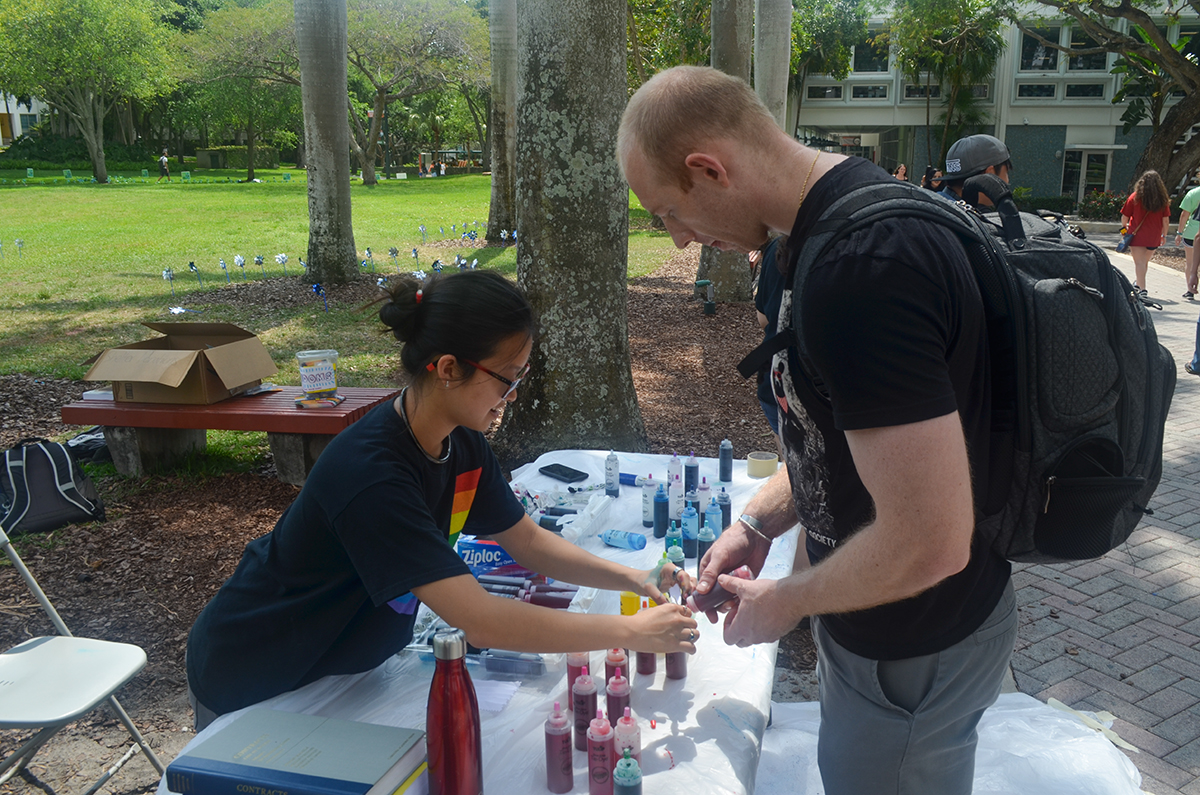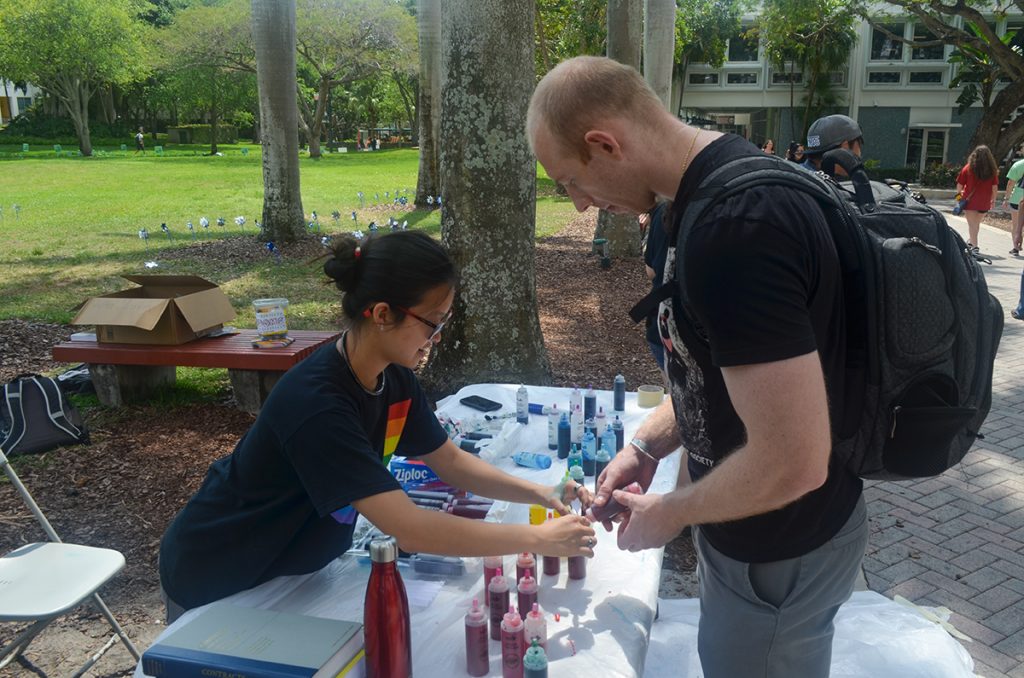

Students in the LGBT community had cause to celebrate during this year’s Pride Awareness Week. Since 2016, the University of Miami has created gender-neutral bathrooms across campus and implemented gender-inclusive housing. Yet, divides and prejudices still remain especially within the Q+ segment of the community.
SpectrUM’s annual Pride Awareness Week (PAW) includes various events aimed at educating students, both inside and outside of the LGBT community, about the human sexuality spectrum. The spectrum includes commonly-labeled sexualities — heterosexuality and homosexuality — but also includes terms that may be seen as more obscure, such as pansexuality. The spectrum also encompasses sexualities and identities that do not fall exclusively under one category.
Senior Evan Morrison identifies as demisexual, meaning he needs to be emotionally attracted to someone before he can feel any sexual attraction. It wasn’t until college, though, that Morrison even learned that the term demisexuality existed.
When he got involved with SpectrUM at the University of Miami, Morrison’s identity started making more sense. Upon arriving at UM, he said he didn’t understand the hookup culture – it was something he wasn’t interested in at all. When he heard about demisexuality, it made sense why.
“I was like, ‘I don’t really understand this. Maybe it’s something I’m missing. I guess I’m just different in that regard,’” Morrison said. “Eventually the concept of demisexuality came up. I was like ‘Oh, wow. That’s how I feel.’”
In his romantic orientation, who he prefers to date, he is pansexual. To Morrison, gender does not matter. When Morrison “came out” during his junior year of high school, he came out as bisexual – despite identifying as pansexual – because he said it was “easier.”
“I didn’t want to deal with ‘Does that mean you’re attracted to kitchenware?’ jokes, because you get a lot of those eventually,” Morrison said.
For Morrison, identifying as part of the Q+ community has led to uncomfortable interactions with his peers and professors. He said because he “passes pretty well” as a straight man, he hears others speaking about the LGBT community without respect to the Q+ community. Morrison said even people who consider themselves gay-friendly or non-homophobic sometimes refer to the community as “LGBT blah blah blah.”
The acronym, which comes in various combinations of order and length, is widely understood to include lesbian, gay, bisexual, transgender, queer and other sexual orientations and gender identities under an umbrella. The Q in the “LGBTQ+” can also stand for individuals questioning their sexuality. According to GLAAD, a national organization that advocates for LGBT rights, “queer” is an adjective that tends to be used more by young people, but is not a universally accepted term by the community because of its past negative connotations.
“I don’t need someone listing an entire 20 character acronym for the LGBTQ+ community, but just tack on a Q or the plus or say those things with some air of respect,” Morrison said. “It’s really meaningful for those people.”
Even in the most updated AP Style Guide used by news organizations, the LGBT acronym excludes the Q+ unless it is referring to the name, such as an event or organization. There is still abundant conversation about what is the most inclusive acronym for the community.
According to a Gallup poll conducted in January 2017, the percent of American adults identifying as lesbian, gay, bisexual or transgender increased from 3.5 percent in 2012 to 4.1 percent in 2016. An estimated 10 million adults identify as LGBT in the United States. However, those numbers exclude other sexual orientations falling under the “Q+” portion of the acronym, including pansexuality.
Emma Lam, a freshman who identifies as pansexual, said her sexual orientation is often misinterpreted as “being potentially interested in anybody” or “interested in threesomes or orgies or something like that.”
“That’s not how it really works,” Lam said. “The label that you choose for yourself is really personal.”
Lam said, for her, pansexuality is a sexual attraction to someone regardless of gender. Though Lam said the definition of pansexuality is different for each person.
Though Lam identifies as pansexual in sexual orientation, she identifies as demiromantic, like Morrison. Lam, who came out to her family and friends in high school, said sexual orientation and romantic orientation are often misinterpreted as correlated to one another.
“There is a difference between your romantic orientation and sexual orientation, but for a lot of people they both line up together,” said Lam, a psychology major. “It should be normalized for people to have different sorts of orientations with everything, so it shouldn’t be a big deal to come out. Unfortunately, it is.”
Lam said she is “pretty open” about her sexual and romantic orientations most of the time but won’t bring the topics up herself unless it’s relevant to finding a potential partner. For others, however, orientation is an integral part of who they are.
“Pride awareness week is really important because the people get to see and realize, ‘Oh wow, I didn’t know this about this person,’” Lam said.
Senior Jeremy Penn is one of an estimated 1.4 million Americans who identify as transgender, according to a study conducted by the Williams Institute at the University of California Los Angeles released in June 2016. Penn said she identifies as trans, non-binary and queer or “somewhere in that flavor.”
Penn said she first came out as gay in her sophomore year of high school and then started identifying as queer in her freshman and sophomore years of college because she felt it suited her better. After that, Penn said she began having a lot of questions about her identity, but it was not until someone told her to “check” her male privilege that she began to unravel her gender identity.
“I sort of started pulling at the strings of that and said, ‘Oh, I really don’t identify as a guy,’” she said.
Through her involvement in SpectrUM, Penn was empowered to use the resources she had obtained to understand and express herself when coming to terms with her gender identity.
“So before, I would’ve said, ‘Well, I don’t fit into your definition of a man,’” Penn said. “And now I can go, ‘Oh I don’t fit into any definition of a man. I don’t feel like one.”
On Feb. 5, Penn came out on Facebook as a transwoman to her friends and family with a post explaining her identity and the struggles and failures placed on trans and non-conforming students by society. Penn said she decided to go public because she “wanted to stop pretending things were okay.” Penn said as a community, society fails transgender and nonbinary people “through structural gender binary.”
Penn said she believes university administrators are doing their part to make the university a more welcoming space for transgender and nonbinary students, but there is still much to be done.
“It’s not that the University of Miami does a bad job on trans issues,” Penn said. “The University of Miami is very good at recognizing that it does not do good on trans issues and I credit them for that. Administrators are aware and actively working on creating changes for trans students.”
In the past few years, UM has applied various LGBT-focused resources to the university, including the LGBTQ Task Force created in 2013 that focuses on advocating for LGBT issues on campus. In August 2016, the university opened an LGBTQ Student Center to give students a welcoming space where they could find whatever LGBT-related resources they need.
This year’s PAW will be Penn’s last major programming event that she will spearhead as a member of SpectrUM’s executive board. After three years of planning the events leading up to and during PAW, Penn said the week means a lot more to her than just visibility and awareness – it’s highly personal.
“It is about letting everyone know that we’re here and we matter and our lives matter and our existence is something that is systematically validated,” Penn said.






